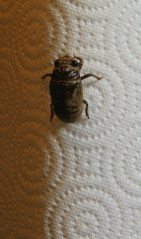On the Origin of Species: Nincada, Ninjask and Shedinja
|
Today's Pokémon are based on an animal well known in many parts of the world, and obscure in others. But if you were in the north-eastern United States in the summer of 2004, there's a good chance you'll be very familiar with these burrowing, swarming and extremely noisy insects.
The Nincada family takes its inspiration from the life cycle of the cicada. There are around 2,500 species of cicadas known to exist, and most are native to temperate and tropical regions. As we'll see, some cicada species have very peculiar strategies for survival, but let's start off with a brief overview of the average cicada's life, and how it relates to the Pokémon it inspired.
Cicada eggs are laid in the bark of trees. Newly-hatched cicadas will drop down to the ground and burrow into the soil, where they may remain for some time. These immature, flightless cicadas are known as nymphs. They're expert diggers and get their nutrients by sucking the fluids from underground roots. It's this stage of the cicada life cycle that inspired Nincada, a Pokémon whose subterranean nature is reflected in its secondary Ground typing.
Eventually, the cicada will tunnel up to the surface, climb up onto a plant, and shed its skin. The adult cicada, which has clear wings and can emit a distinctive buzzing sound, is the inspiration for Ninjask, Nincada's evolution. But, as those familiar with the series will know, there's a mysterious third member to this family. The cicada's shed skin remains clinging to the plant, and can easily be mistaken for the real thing. Since cicadas tend to emerge and molt in large numbers, you're likely to find plenty of these shed skins following such an emergence. There is something slightly eerie about these lifeless, hollow cicadas, and indeed, they inspired Shedinja, a Pokémon that (space permitting) you may find in your party after the evolution of Nincada to Ninjask.

Cicadas aren't always the most popular of insects, and this probably has a lot to do with their habit of emerging from the ground in large numbers, not to mention their incessant buzzing. Nonetheless, these are quite docile, harmless creatures that pose no threat to us humans. The worst you can expect from a cicada is a poke from their proboscis – and this only happens if you stand still for long enough to convince them that you're a tree.
So cicadas are benign, but they probably don't come across as all that cunning. They have no apparent means of defense, and they're easy pickings for predators once they've emerged from the ground. It may come as a surprise, then, to learn that some species of cicada have developed a strategy for survival that's based around mathematics – specifically, prime numbers.
A prime number is a number that can only be divided by itself and one. 2, 3, 5, 7, 11, 13 and 17 are all prime numbers... but 15 isn't, because it can be divided by 5 to give 3. Primes are very important in the fields of mathematics and computing, and are currently used for data encryption. They were probably known to the ancient Egyptians, but regardless of which human civilization discovered them, cicadas got there first... in a roundabout sort of way.
North America is home to a genus of cicadas called Magicicada. These cicadas are periodical, meaning that they live underground for long periods of time before emerging, en masse, after a predetermined number of years. This means that the cicada nymphs have to keep track of the time while underground, which they apparently do by sensing minute changes in the composition of the juice that they drink from tree roots. There are four Magicicada species with a 13-year life cycle, and three species with a 17-year life cycle. Once biologists realized the length of the cycles, they were immediately drawn to the fact that both of the numbers – 13 and 17 – are prime. Might there have been some reason that the North American cicadas had developed prime numbered life cycles?
Well, one popular theory was that cycles of large prime numbers tend not to coincide with each other. Imagine a 13-year cicada species sharing the same territory as a 17-year species. It would be very rare for them to emerge in the same year: once every 221 years, to be exact. Thus, they wouldn't usually be in competition for food. As nice as this theory is, it ignores the fact that, in most cases, 13-year species don't actually share territory with 17-year species. The 17-year species live mostly in the north-east of the USA, while the 13-year cicadas prefer the south-east. So there must be another reason for these numbers.
The current theory, developed by Professor Mario Markus of the Max Planck Institute in Germany, is based around the idea that prime numbers are useful for avoiding potential predators. Just as cicadas have periodic life cycles, so do many predators. Let's picture a cicada species that emerges from the ground every 12 years. These would be vulnerable to the predators that come around every second year, plus those that come around every third year, every fourth year and every sixth year. There would be no shortage of predators queuing up to devour our 12-year cicada.
But let's increase that cycle length by just one year, and see what happens. Because 13 is a prime number, a 13-year cycle isn't going to regularly coincide with the cycles of predators. Let's imagine that a 13-year cicada species happens to emerge while a 4-year predator is in the area. Plenty of the cicadas will be eaten on this occasion, but the two species won't meet again for another 52 years. With such a long period of time between meetings, the predator isn't going to be able to reliably predict when the cicadas are due to emerge.
So, prime-numbered cycles seem to help cicadas maintain the element of surprise, catching their predators off-guard. Their other strategy is what's known as predator satiation, meaning that they emerge together in such huge numbers that predators can't possibly eat them all. It's safety in numbers, basically, and these strategies combined have made the periodic cicadas a very successful group of species.
In the summer of 2004, the largest group of 17-year cicadas, known as Brood X, surfaced in the north-eastern United States. Around fifteen states were suddenly teeming in cicadas, all of them in a hurry to shed their skin and mate, before ultimately dying off soon afterwards. Quite an alarming spectacle, even though the cicadas were entirely harmless.
And now, a notice for anybody reading this in the states of Alabama, Arkansas, Georgia, Indiana, Illinois, Kentucky, Louisiana, Missouri, Mississippi, North Carolina, Oklahoma, South Carolina, Tennessee and Virginia. I have good news for all of you! The largest group of 13-year cicadas, Brood XIX, is burrowing through the soil beneath your feet as you read this. They'll be emerging about a year from now, in the summer of 2011. All predictions are that it's going to be spectacular... and loud. So very loud. Look forward to it!
